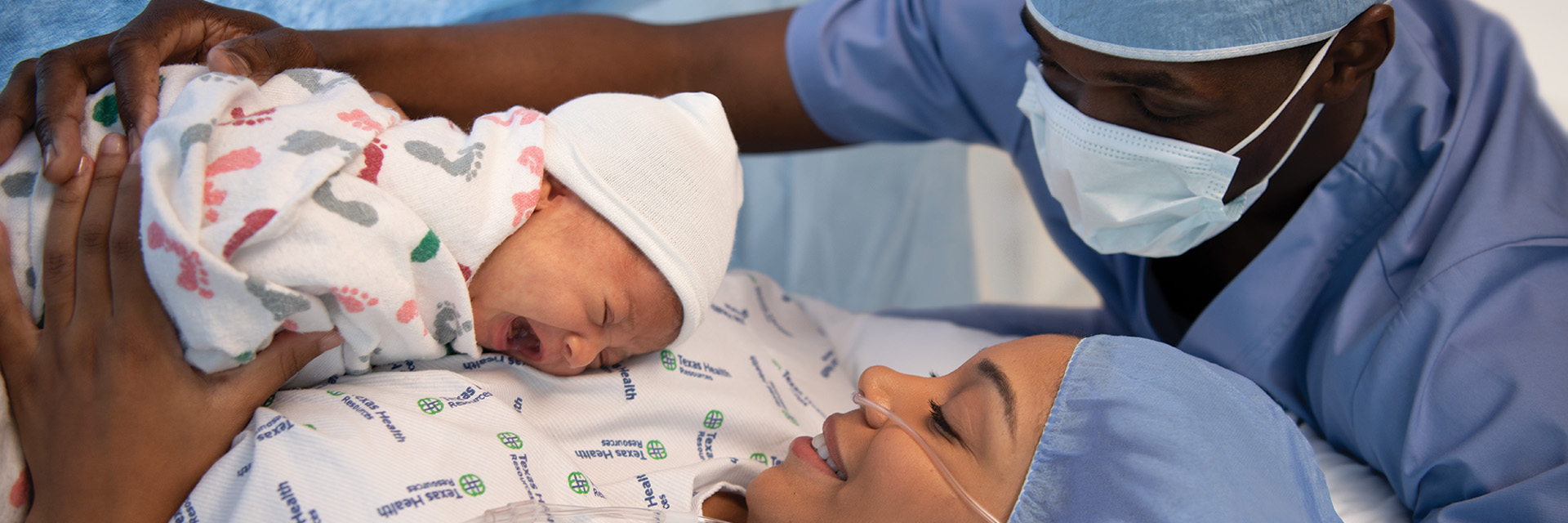While many C-sections are planned in advance, some are necessary if complications arise during pregnancy or delivery. Understanding what to expect can help ease any nerves you have.
For medical reasons, your doctor has recommended a cesarean (C-section) delivery. C-sections are one of the most commonly performed surgeries and can help ensure a happy, healthy and safe baby and mother. Whether planned or a decision that’s made during the labor process, Texas Health wants to help moms-to-be understand what to expect during this major surgery.
Getting expectant mothers emotionally and physically prepared for the procedure is something that Jill Johnson, a registered nurse and childbirth education coordinator at Texas Health Presbyterian Hospital Dallas, knows all too well. Here are some insights on all things cesarean, beginning with the pre-surgery activities that commonly take place.
The Preparation

“The preparation process can vary depending on why you are having a C-section, but typically pre-op consists of cleansing and sterilizing the abdominal surgical area, the placement of a catheter tube into your bladder to collect urine and the placement of an IV in your hand or arm to provide fluid and medication,” Johnson says. “You might be given an antacid as well, to reduce the risk of an upset stomach during the procedure and you will be hooked up to a monitor that will continuously report vital signs such as blood pressure and heart rate to the attending staff throughout the surgery.”
Most C-sections are done under regional anesthesia, which numbs only the lower part of your body, allowing you to remain awake during the procedure. A common choice is a spinal epidural, which effectively delivers pain relief medication directly to the fluid area that surrounds the spinal cord.
“To prepare for an epidural insertion, part of the lower back will be cleaned and sterilized with antiseptic. The anesthesiologist will have you sit on the side of the bed and lean over with the help of a support person or nurse so that an epidural catheter may be placed and secured with tape. Numbing medication will be delivered through the epidural catheter for as long as needed. Most moms find that the medication becomes fully effective in about 10 to 20 minutes,” Johnson says.
On To Surgery
In the operating room, your designated support person will suit up in scrubs and a mask in preparation for accompanying you through the procedure. According to Johnson, the role of the support person during a cesarean delivery is just as important as the role of a significant other during a vaginal birth.
“Whether the cesarean birth was planned or not, you will need verbal reassurance and moral support during the birth. This is where your support person becomes so important,” Johnson says. “This person will be seated at the head of the table next to you and a drape will be pulled across your midsection so that, in addition to not feeling the procedure, you won’t see it either. In many hospitals, moms do have the choice to request a gentle C-section which means you can have a clear drape through which to view the birth.”
So what happens on the other side of the drape? You’re likely to hear a fair amount of activity in the room: a scrub nurse, another nurse or two, the anesthesiologist, your obstetrician and perhaps a pediatrician.

“The obstetrician will make an incision in your abdomen about as long as your middle finger and then more internal incisions to allow for baby’s delivery,” says Sheri Puffer, M.D., an OB/GYN and physician on the medical staff at Texas Health Arlington Memorial Hospital. “Your doctor will clear your baby’s mouth and nose of fluids once delivered, then clamp and cut the umbilical cord. The placenta will be removed from your uterus and the incisions will be closed with sutures. All in all, the entire procedure generally takes about an hour.”
Your Recovery
Recovery after a c-section (also known as a cesarean section) can vary depending on the individual, the circumstances of the surgery, and any potential complications. A recovery room will be home to you and your newborn for the first two hours after surgery. During this time, your pain level and vital signs will continue to be monitored by the Labor & Delivery (L&D) nursing staff. Pain management is an important part of the recovery process and oral pain medication may be offered once the epidural is removed.
“During the recovery-room period, we also encourage moms to initiate skin-to-skin contact with their babies to begin the bonding process,” Johnson says. “Your bedside nurse will stay with you in L&D until you are transferred to a postpartum room to continue your recovery for several more days.”
Generally, the recovery period after a c-section can be broken down into several stages.
- Hospital Stay: Typically, you'll spend two to four days in the hospital after a c-section. During this time, your health care team will monitor your incision site, pain levels, and any potential complications, such as infection or blood clots.
- Pain Management: You'll likely experience some pain and discomfort after the surgery, and your health care team will provide you with pain medication to help manage this. It's important to follow the medication schedule and avoid overexertion during this time.
- Movement: You'll be encouraged to start moving around as soon as possible after the surgery, but you'll need to take it slowly and carefully. Walking short distances, such as to the bathroom, can help prevent blood clots and promote healing.
- Incision Care: You'll need to keep your incision site clean and dry to prevent infection. Your health care team will provide you with instructions on how to care for your incision and what signs to look for that may indicate a problem.
- Breastfeeding: If you plan to breastfeed, you can usually start doing so soon after the surgery. However, you may need to experiment with different positions and techniques to find what works best for you.
- Follow-Up Care: You'll have a follow-up appointment with your health care provider to ensure that you're healing properly and to discuss any ongoing concerns or questions you may have.
As with any major surgical procedure, there can be some side effects. With a cesarean, you might experience shivering, backache, soreness or itching where the epidural was inserted, nausea and/or some postpartum swelling. Johnson noted that the most common side effect is a headache that can result from the use of anesthesia. Oral pain medications and a 24-hour liquid diet are often prescribed to alleviate the side effects and get Mom on her way to recovery.
“We usually tell people recovery is around six weeks for a vaginal delivery and about eight weeks for a C-section,” Puffer explains. “We are very fortunate that we are able to perform C-sections safely in this country, and we perform them frequently. However, sometimes I think it can be easy for someone to forget that childbirth is a very big deal and a C-section is still a major surgery. We make an incision into your abdomen through many, many layers and then we have to sew all those layers back up. It takes time to heal something like that. So please be patient with yourself and your body.”
If You Can’t Avoid a C-Section, Embrace Your Experience
It's important to note that even with the best preparations and intentions, sometimes a C-section may still be necessary for the health and safety of the mother and baby.
“Of course, if we go with a natural delivery plan and then circumstances pop up that preclude us from going forward with that, we are lucky to have the ability to perform c-sections safely in our country,” Puffer says. “However, I know the shame so many women can feel if they end up having to have a medically necessary C-section. Unfortunately, we see that all the time. They may have wanted a vaginal delivery very badly and for whatever reason, that wasn’t possible.
“I always tell my mom that the No. 1 goal is a safe baby and a safe mom. And if you have that, then you are blessed and it does not matter how that baby was brought into this world,” she adds. “If you have a happy, healthy baby in your arms, and a happy, healthy mom, that is the goal for everyone involved.”
Additionally, Puffer recommends reaching out for support if you’re struggling with your labor and delivery experience.
“We, as a society, do put a lot of pressure on moms for so many things,” she says. “So, I just urge people to always reach out to their doctor after having their baby if they’re feeling down because it’s very common; 40% of women experience post-partum depression and mode of delivery can contribute to that. Do not be afraid to ask for help.”
For more help and guidance about what to expect during your pregnancy, visit Women and Infant Services and join the Texas Health Moms Facebook page, a private group where you can network with other moms, swap ideas and share helpful advice.
Sources:

